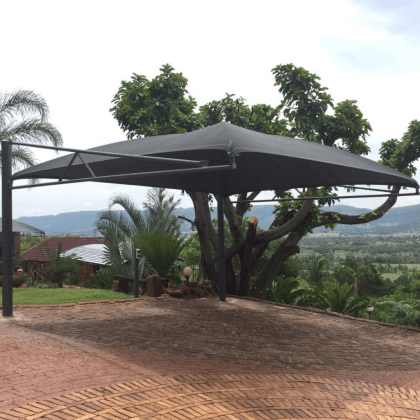
Shadeports are a popular way to keep vehicles and outdoor spaces shielded from direct sunlight. Many people find these structures beneficial in combating intense UV rays while also enhancing the look of the property. Ultimately, it all comes down to the material you choose, as that will directly influence the structure’s effectiveness and longevity.
In this article, we will discuss selecting a robust cloth for overhead protection, examining the features that make some fabrics more effective than others. We will also explore the importance of weave, weight, and maintenance, so you’ll know exactly how to keep your shade setup in top condition.
Understanding Common Shadeport Fabrics
Shadeport covers generally come in a handful of material types, each offering distinct advantages. Among the most common and widely used options is high-density polyethylene (HDPE), recognizable for its knitted construction that allows hot air to escape while still blocking a large percentage of UV rays. PVC-coated fabrics are another choice, often lauded for their ease of cleaning and resistance to moisture. Finding the strongest textile for lasting coverage involves understanding these different materials and seeing how they fare under constant sun exposure.
Durability is the main consideration when choosing any shadeport cover. HDPE leads the pack for strength and resilience because it is treated with UV stabilizers, protecting it against deterioration. Knitted HDPE also generally resists tears and fraying, making it particularly suited for setups that face exposure to strong winds and periodic storms. Meanwhile, PVC-based materials have a solid track record for repelling light rain, though knots or creases could reduce long-term performance if not addressed promptly.
Thickness and density further separate one type of shade material from another. A tighter weave offers improved shade and additional UV resistance, but it is crucial to strike a balance between adequate airflow and sun coverage. This equilibrium ensures that your space remains cooler while also safeguarding vehicles, patios, or play areas. Identifying the most resilient netting for year-round reliability often comes down to matching your local climate with the right density and weave type.
Focus on Fabric Weight and Weave
Weight matters just as much as the material type, because it correlates with how long a cover can withstand constant exposure to the elements. A heavier netting is less likely to stretch or sag over time, which means more consistent shade without the hassle of frequent adjustments or replacements. Select a fabric weight that feels substantial but not overly restrictive to airflow, because a stuffy environment beneath the canopy defeats the purpose of a comfortable refuge.
The weave also plays a vital role. Knitted shade nets tend to offer a good combination of breathability and coverage, while woven materials can provide a tighter seal against harmful UV rays. For homeowners or businesses in high-sun regions, a close-knit weave that still maintains ventilation is ideal. It ensures that even when temperatures soar, hot air won’t accumulate under your canopy.
Additionally, coloration affects performance. Darker colors typically offer better UV block, but they may slightly reduce the amount of light passing through, leading to cooler interior conditions. Lighter shades bring a bit more warmth indoors, although they can still be combined with UV inhibitors to equalize protection. Balancing color choice with overall construction helps in choosing the right shadeport cover for both visual appeal and functionality.
Maintenance and Longevity Factors
A dependable shadeport cover should stand up to frequent weather shifts without requiring constant care. However, a basic level of upkeep will help prolong its lifespan. Routine inspections for small tears or worn areas allow you to address them early, preventing problems from spreading. Gently cleaning the surface removes accumulated dirt, which reduces the risk of abrasion and fading.
Hardware quality is another piece of the puzzle. While the fabric itself might be top-notch, subpar fittings or anchors could compromise the entire structure. Periodically tighten any loose bolts or brackets to keep the canopy secure and well-tensioned. This simple habit lets the material do its job effectively while decreasing stress points that could lead to premature wear.
Finally, proper installation is key to avoiding damage. Although many fabrics boast robust design, poor setup typically leads to uneven stress along seams and edges. By pairing good installation methods with a premium material, you effectively ensure your shade structure will serve you well for years to come. In many cases, choosing a high-quality cover is the difference between frequent maintenance and a hassle-free, long-lasting canopy.
In Conclusion
Selecting the most suitable material for your shade shelter is crucial for maximum sun protection and longevity. From HDPE’s breathable knit to PVC-coated options, each fabric has its strengths. By focusing on proper weight, weave, and diligent maintenance, you can enjoy cool comfort and reduced UV exposure under your shade.
If you are ready to protect your property from the harsh sun, get in touch with us for our free quotation. We look forward to offering our expertise and delivering a shadeport solution that stands the test of time. Get a free quotation and see how we can help bring reliable coverage to your space.

Mike Shades is an experienced shade netting specialist with over 13 years of expertise in manufacturing and installing high-quality shade structures. His dedication to providing cost-effective solutions with a 10-year warranty on materials reflects his commitment to excellence. Based in Gauteng, Mike’s innovative designs cater to various needs, ensuring top-notch service and unbeatable prices.



